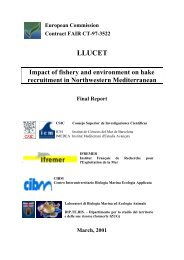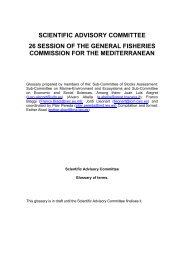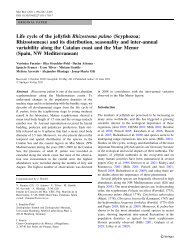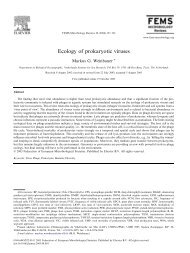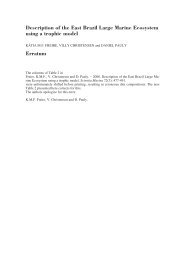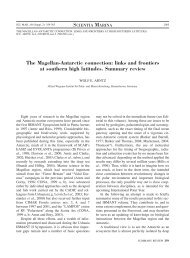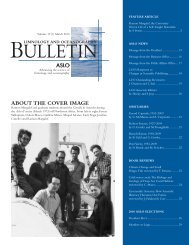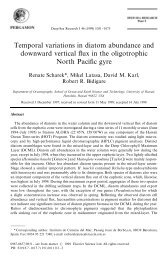REPORT OF THE WORKSHOP ON TRAWL SURVEY ... - FAO.org
REPORT OF THE WORKSHOP ON TRAWL SURVEY ... - FAO.org
REPORT OF THE WORKSHOP ON TRAWL SURVEY ... - FAO.org
You also want an ePaper? Increase the reach of your titles
YUMPU automatically turns print PDFs into web optimized ePapers that Google loves.
(i.e. ratios Ln (N a+1,y+1 /N a,y )) can be separated into an age effect and a year effect.<br />
The simplest approach is given by Shepherd and Nicholson (1991), involving a multiplicative<br />
model with three factors: year, age and year class. This approach explicitly incorporates the<br />
form of error distribution but requires the imposition of a trend in the year effect (e.g. based<br />
on fishing effort) to provide a unique solution. This approach can be used with fishery catch<br />
or survey data, and is currently used by the NWWG (2006) to screen fishery age composition<br />
data.<br />
The model SURBA (Survey Based Assessment), derived from an analysis of survey data<br />
given by Cook (1997, 2004), is used widely by ICES Working Groups to provide modelbased<br />
estimates of recruitment, SSB and total mortality (Needle, 2004). In essence:<br />
Z a,y = s a . Z y<br />
where s a and f y are the age and year effects in total mortality.<br />
Abundance is modelled as:<br />
N a,y = N a0, y-a+a0 exp ( -Z’)<br />
where N a0, y-a+a0 is the number of fish at the recruitment age (a 0 ) in the same yearclass and Z’<br />
is the cumulative total mortality from age a 0 to age a in the year class.<br />
Parameters are estimated by minimising the sums of squared differences between observed<br />
and modelled abundance indices. Smoothing options are provided. The current version of the<br />
model allows simultaneous analysis of multiple surveys (may not have been fully simulation<br />
tested yet).<br />
Experience with applying SURBA to a variety of survey data within the ICES Northern Shelf<br />
and North Sea WGs has shown that, if survey selectivity has remained more or less constant<br />
over time, the model provides smoother and more realistic biomass and recruitment trends<br />
than given by the error-prone raw data. However, the method cannot give unbiased estimates<br />
of Z for all ages without auxiliary information to estimate the pattern of catchability at age.<br />
The ICES Working Group on the Assessment of Northern Shelf Demersal stocks has for some<br />
stocks used mean catchability at age from an appropriate converged part of a catch at age<br />
assessment such as XSA to define the catchabilities in SURBA, to allow a direct comparison<br />
of absolute values with XSA. However, survey catch-curves also reflect age-dependent<br />
natural mortality and emigration effects not modelled in XSA for these stocks. .<br />
There are methodological difficulties in estimating trends in Z for the recent years using<br />
SURBA. Longer-term trends in the steepness of the catch curves may indicate trends in Z, but<br />
there is generally insufficient information to estimate Z for the most recent years. Hence,<br />
SURBA currently uses an assumption that the year effect in Z in the final year is equal to the<br />
average for the preceeding three years. Catchability at the oldest age is also assumed the same<br />
as for the next youngest age.<br />
The SURBA software provides limited diagnostic plots to help interpret the model fit. Users<br />
can manually alter the catchability at age to “straighten” out the fitted catch curves at the<br />
youngest ages as described above – however including partially selected younger age groups<br />
(which may also be subject to more variable selectivity and mortality) may actually degrade<br />
the overall model fit.<br />
53




